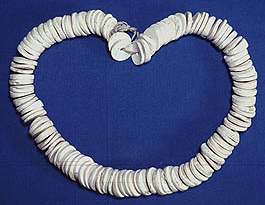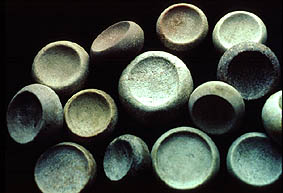
Finely made arrow points from Mound 72, Cahokia
Therefore, identification of full-time craft specialists requires more that just the presence of particularly well-made, beautiful objects. Archaeological data also required include the following:

Marine shell bead necklace.
|
While some Mississippian goods from the American Bottom (such as the fire clay
figurines, Cahokia points from burials, shell bead necklaces, and perhaps
Ramey-Incised pots) were produced by skilled people, there is little or no
archaeological evidence of full-time specialists. It is worth noting, for
example, that with the possible exception of a high density of chert drills in
a few storage pits at Cahokia, no workshops have been excavated. Present
archaeological evidence seems to indicate that the people who produced much of
the prestige and high quality goods in the American Bottom did so, at most, on
a part-time basis. With the possible exception of religious specialists of the
highest rank, there is no evidence of an full-time class of craftsmen.
|

Chunkey stones from Mound 72, Cahokia Mounds Museum. |
Nevertheless, it is worth considering the functions of the items that skilled Mississippian artisans produced. Finely crafted goods such as Ramey-Incised pots, Cahokia points, polished chunkey stones, and other objects all serve three main functions. (1) They are visible signs of wealth and prestige. (2) They are visible signs that the owner has special socio-political and religious connections (see below and ART). (3) They serve as powerful items of exchange for other material goods, to curry favour with others, as well as for payment to meet social, political, and religious obligations. Owners use their prestige items and objects of wealth to manipulate others, to gain more power and wealth. |